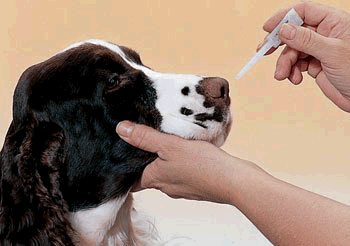Immunization Awareness Month: Canine Vaccines
So, we will wrap up this immunization awareness month with canine vaccines. I will briefly describe the common canine vaccines, and I will then tell you that I took a straw poll of several practitioners to let you know what is commonly being done here in OKC.
DHLPP
D - This is the “distemper shot.” Distemper is a virus that is related to measles, and it starts with respiratory signs (runny eyes, nasal discharge, and occasionally pneumonia). Dogs can then have vomiting and diarrhea, or they can develop hard callouses on their nose and footpads. They can also develop seizures. The classic distemper seizure is the “chewing gum” seizure, which is characterized by jaw snapping.

H – The “H” stands for infectious hepatitis, and it is caused by the canine adenovirus-1. Because of this, some veterinarians will call the vaccine DALPP. This virus affects the liver, and 20% of affected dogs will also get corneal edema or “blue eye.” To complicate matters further, canine adenovirus-2 contributes to the upper respiratory complex that we will discuss later.

L - The “L” stands for leptospirosis. This is actually a bacteria, and there are multiple strains of disease. When vaccines contain leptospirosis in them, they will have either 2 or 4 strains. The leptospirosis component of the vaccine has been implicated as the cause for increased vaccine reactions, but recent studies have disproven this belief. Although leptospirosis can affect either the liver or the kidneys, we see the form that affects the kidneys more frequently in Oklahoma. The bacteria are shed in urine, and this disease is zoonotic. This means that an infected dog can infect people, and the disease can cause the kidneys to fail in people, too. When people are infected, the clinical signs initially mimic influenza with fever and muscle aches. Unfortunately, the disease then gets misdiagnosed, and people can even die from leptospirosis. This is a serious disease, and in my opinion, we should vaccinate for it. The protection from this vaccine is fairly short, and boosters should be given yearly.

P - One “P” stands for parainfluenza, and this virus is part of the respiratory complex that dogs get.
P - The other “P” stands for parvovirus. This is a dangerous virus that causes severe vomiting and diarrhea in puppies. They often have abdominal pain, and they can become profoundly dehydrated. Without treatment, survival is approximately 10%, but with appropriate aggressive therapy, survival may be as high as 90%.
Kennel Cough (Bordetella bronchiseptica)
Actually, kennel cough is an infectious bronchitis that is caused by numerous organisms. In fact, most dogs that get kennel cough have a combination of several of these organisms, including Bordetella bronchiseptica (which is a bacteria), parainfluenza, canine adenovirus-2, or distemper. This causes dogs to cough. And cough. And cough. And cough. This is tiring, exhausting, and annoying for the dogs and the owners. The vaccine only protects against Bordetella bronchiseptica, though. It can be given in the nose, in the mouth, or as an actual shot. The oral and intranasal forms provide more rapid protection from infection, and they provide superior protection.

Now, there are certainly other vaccines available. There is an influenza vaccine, and this may be necessary in some dogs at high risk of exposure. There is a vaccine for Lyme disease. Lyme disease is not a huge risk in Oklahoma, and Lyme disease is pretty easy to treat. There is even a vaccine for rattlesnake bites.

Here is where I took my straw poll since I don’t keep any vaccines at my office. Puppies need vaccines every 3 weeks starting at 6-8 weeks of age until they are 16-20 weeks. This allows them to develop immunity to disease as the maternal antibodies that they get in colostrum wear off. Although there is a consensus of the timing of puppy vaccines, some of my colleagues give DHPP first with only 2 doses of leptospirosis starting at 12 weeks, and others give DHLPP the whole way through. Most give two doses of Bordetella starting at 12 weeks.
All dogs should be revaccinated with DHLPP and Bordetella one year after their initial vaccines. After that, the consensus is gone. Many veterinarians give leptospirosis yearly as we see a fair number of cases of this disease. The DHPP portion of the vaccine can be given every 3 years although some colleagues give the entire vaccine yearly (this is often dependent on city statutes). With Bordetella, yearly boosters should be given except in high risk dogs, and they need this vaccine every 6 months.
Well, I hope this helps answer your questions on canine vaccines. Like we talked about last week, you should always talk to your veterinarian about designing the vaccine protocol for your own personal dogs. Some dogs are at greater risk of exposure to disease. Some should have their vaccines spread out because of their small size, and others need to have their protocol adjusted because of an adverse reaction to a vaccine.
Next week, we will be writing a tribute blog to many of our friends who have already crossed the Rainbow Bridge. If you would like to be included, please send us a picture and tell us about your special fur baby.




















